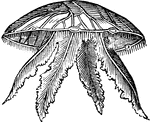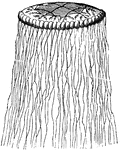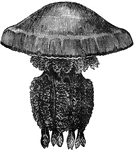Clipart tagged: ‘discophora’

Medusa, aurita
"One of the commonest species, and must have been observed by those who frequent the sea-shore. In the…

Cuvieria carisochroma
"Which is without a central peduncle, yet has numerous long appendages hanging from its border." —…

Rhizostoma cuvieri
"The Rhisostoma Cuvieri, a British species, measures two feet, or ever more, in diameter, while…

Pelagia labiche
"With four foliaceous arms, and long filaments depending from the rim of th umbrella, also found in…

Favonia octonema
"With a nearly hemispherical body, showing a long proboscis, at the root of which are eight branchiferous…